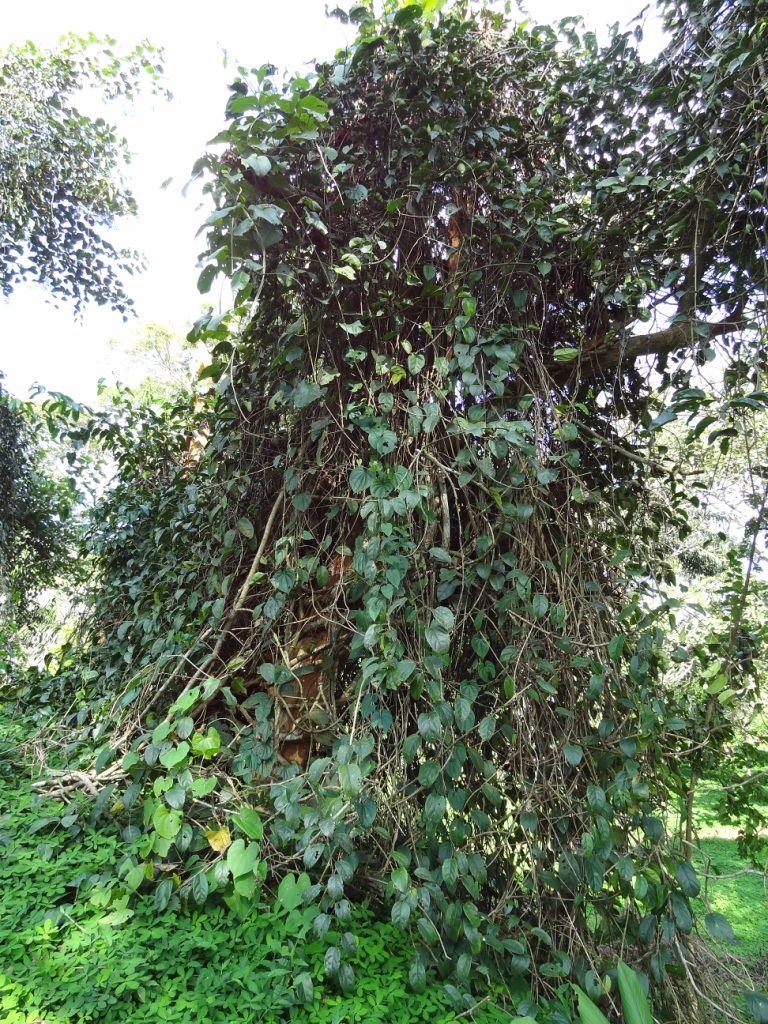Tetracarpidium conophorum

|
|
Tetracarpidium conophorum Common Names: African Walnut, Conophor Nut, Nigerian
Walnut Species ID: NMP-182 | wfo-0000321534 | NCBI_Taxonomy ID: 41696 Scientific
Classification Kingdom: Plantae Phylum: Tracheophyta Class: Magnoliopsida Order: Malpighiales Family: Euphorbiaceae Genus: Tetracarpidium Species: T. conophorum Synonyms: Plukenetia conophora (Müll.Arg.) Small Description Tetracarpidium conophorum, commonly known as the African Walnut, is a perennial climbing
shrub reaching 3–6 m in height, occasionally up to 10 m with support from
larger trees. Its key features include: · Stem: Woody, flexible, climbing with twining branches · Leaves: Alternate, elliptic to ovate, 5–15 cm long, 3–7 cm wide,
dark green, glossy · Flowers: Small, greenish-white, borne in axillary clusters, dioecious · Fruit: Greenish capsule, 5–8 cm long, containing 3–4 hard-shelled
seeds; seeds yield a light golden oil rich in linolenic acid The seeds, encased in a
tough shell, have a kola-like aroma when raw and are consumed boiled or
roasted, valued for their nutty flavor (Fern, 2024). Distribution and Habitat Tetracarpidium conophorum is native to western and central tropical Africa, from Togo
and Nigeria to Cameroon, Gabon, and the Congo. It thrives in: · Ecosystems: Rainforests, secondary forests, low bushes, and plantation
understories · Climate: Tropical, with rainfall of 1,500–3,000 mm annually and
temperatures of 22–35°C · Soils: Well-drained, loamy to sandy, rich in organic matter · Altitude: 250–1,400 m Ethnopharmacology Tetracarpidium conophorum, commonly known as the African walnut, is a medicinal plant
widely used in West African traditional medicine for its therapeutic benefits.
Various parts of the plant, particularly the nuts, leaves, and bark—have
demonstrated notable pharmacological properties, including antioxidant,
antimicrobial, anti-inflammatory, analgesic, antidiabetic, and aphrodisiac
effects. The nut is traditionally consumed to enhance male fertility, and
studies have shown it can improve sperm quality and testosterone levels in
animal models. Its leaves have been reported to lower blood glucose levels and
possess neuroprotective and memory-enhancing effects, likely due to their high
phenolic and omega-3 fatty acid content. Phytochemical analyses have revealed
the presence of flavonoids, alkaloids, saponins, tannins, and phenolic
compounds. While generally safe in traditional doses, some studies suggest that
high concentrations may have mild toxic effects, warranting further
investigation into its safety profile. · Anti-obesity Effects: In Nigeria, ethanol seed extracts upregulated
adiponectin and PPAR-γ expression by 19.1% and suppressed TNF-α by 30% in obese
rats, indicating anti-inflammatory and weight-regulating potential (Umoru et
al., 2024). · Antioxidant Activity: Leaf extracts inhibited DPPH radicals by
54.45% at 0.1 mg/mL, comparable to rutin, due to high phenolic and flavonoid
content, supporting its use for oxidative stress reduction (Amaeze et al.,
2011). · Antidiabetic Properties: its use for diabetes management. · Antibacterial Activity: Leaf extracts inhibited Staphylococcus aureus (MIC 0.058 mg/mL), supporting its
traditional use for wound healing and infections (Akande & Hayashi, 1998). · Male Fertility Enhancement: Aqueous leaf extracts increased sperm
motility and testosterone levels in rats by 25% at 500 mg/kg, confirming its
folklore use as a fertility enhancer (Akomolafe et al., 2015). · Antiulcer Effects: Its use for digestive health ⚠ Toxicity Profile: No significant toxicity is reported for Tetracarpidium
conophorum. Acute toxicity studies
in rats showed no adverse effects at doses up to 5,000 mg/kg. However,
excessive consumption may cause mild gastrointestinal discomfort due to high
oil content. Traditional use within recommended doses is considered safe
(Awotunde et al., 2019). Additional Uses · Culinary: Seeds are boiled or roasted as a snack, rich in protein
(24%) and lipids (40%), contributing to nutritional security (Fern, 2024). · Industrial: Seed oil, high in linolenic acid, is used in cosmetics and
as a food-grade oil; bark tannins are used for dyeing. · Ecological: Supports biodiversity by providing habitat for small mammals
and birds; aids soil stabilization in plantations (Clayton et al., 2016). · Economic: Nut sales enhance rural incomes, reducing poverty in Nigeria
and Cameroon; however, seasonal availability limits scalability (Burkill,
1995). References
External Links More Pictures |
|
| Compounds of Tetracarpidium conophorum | |
| References |